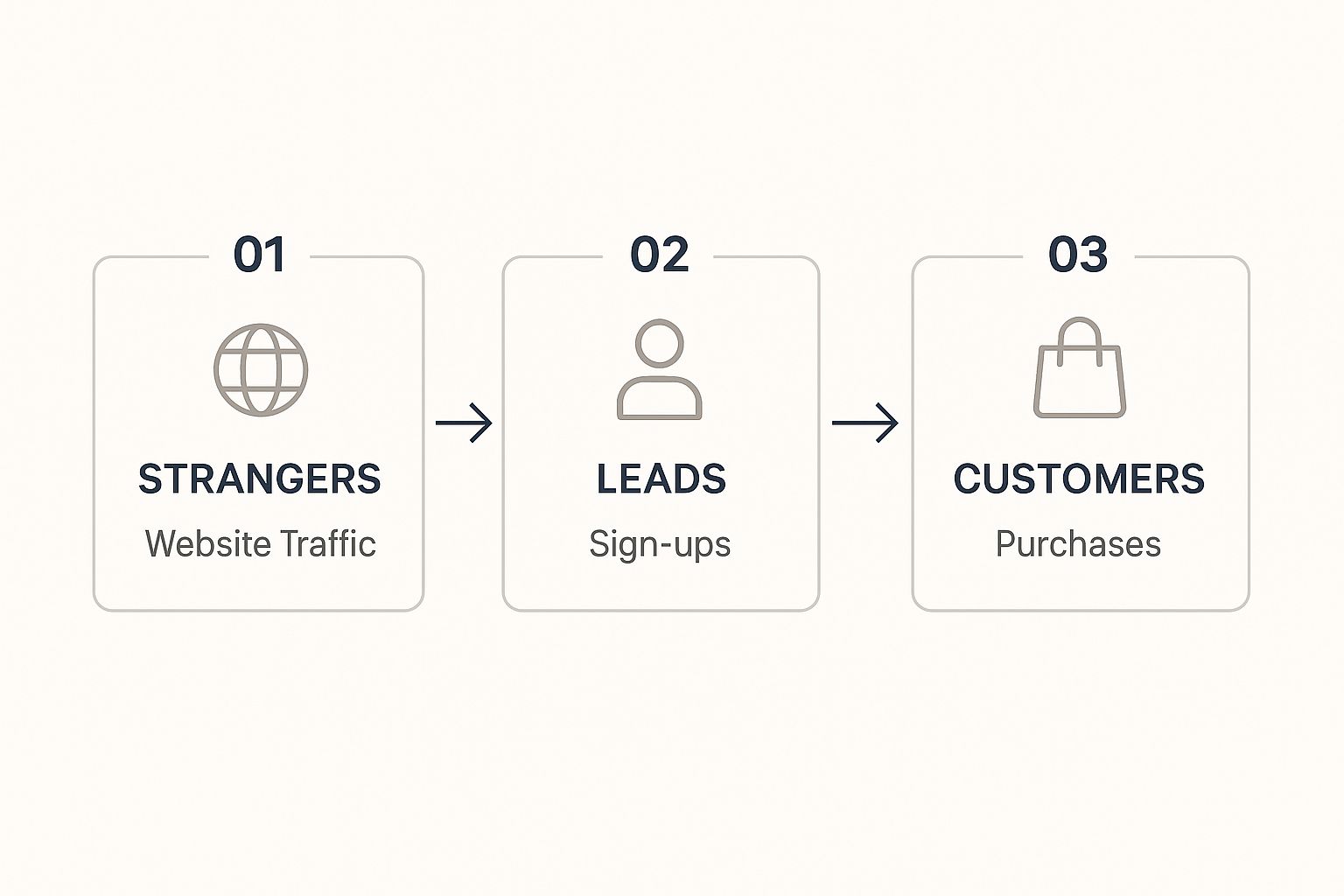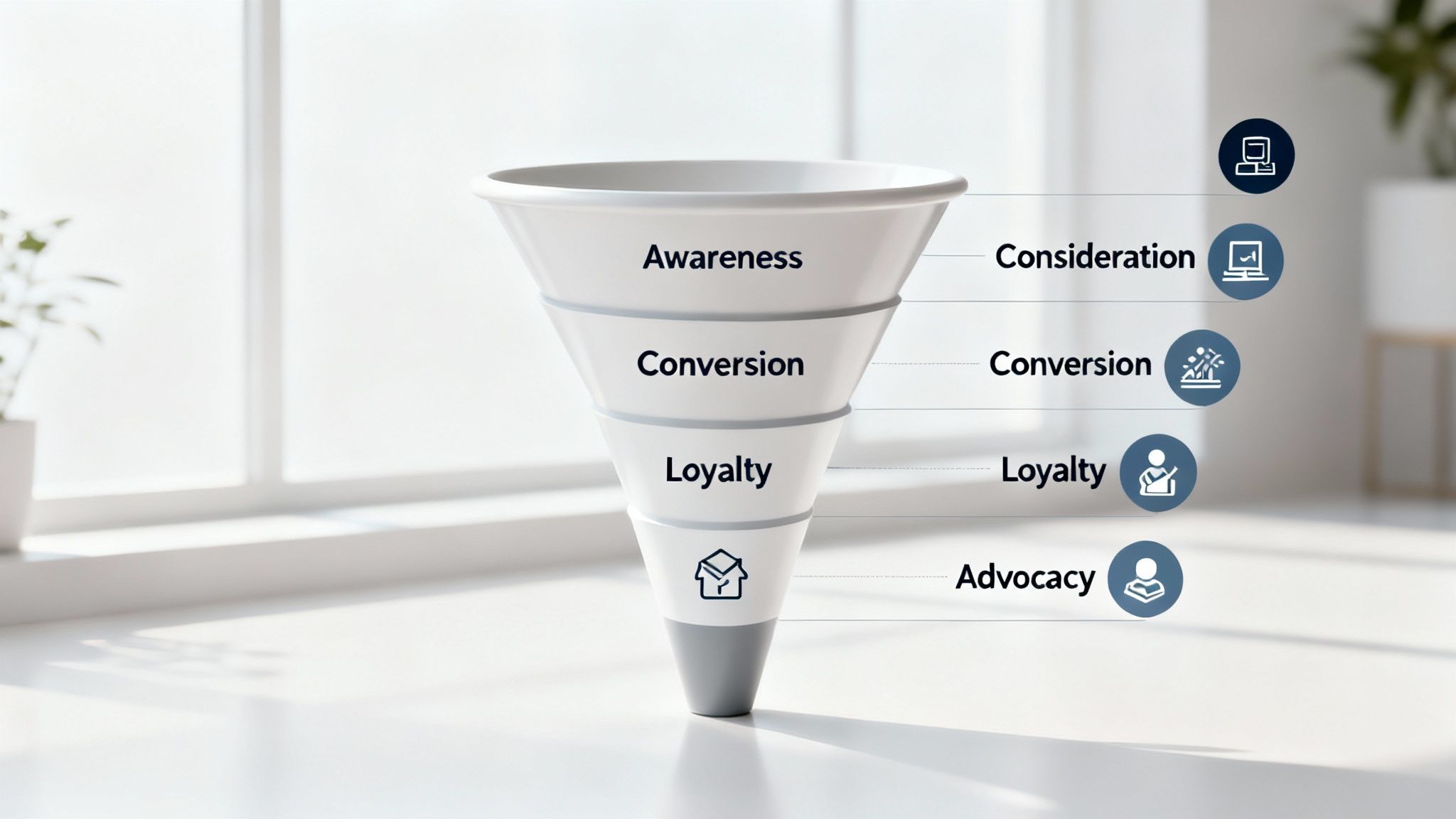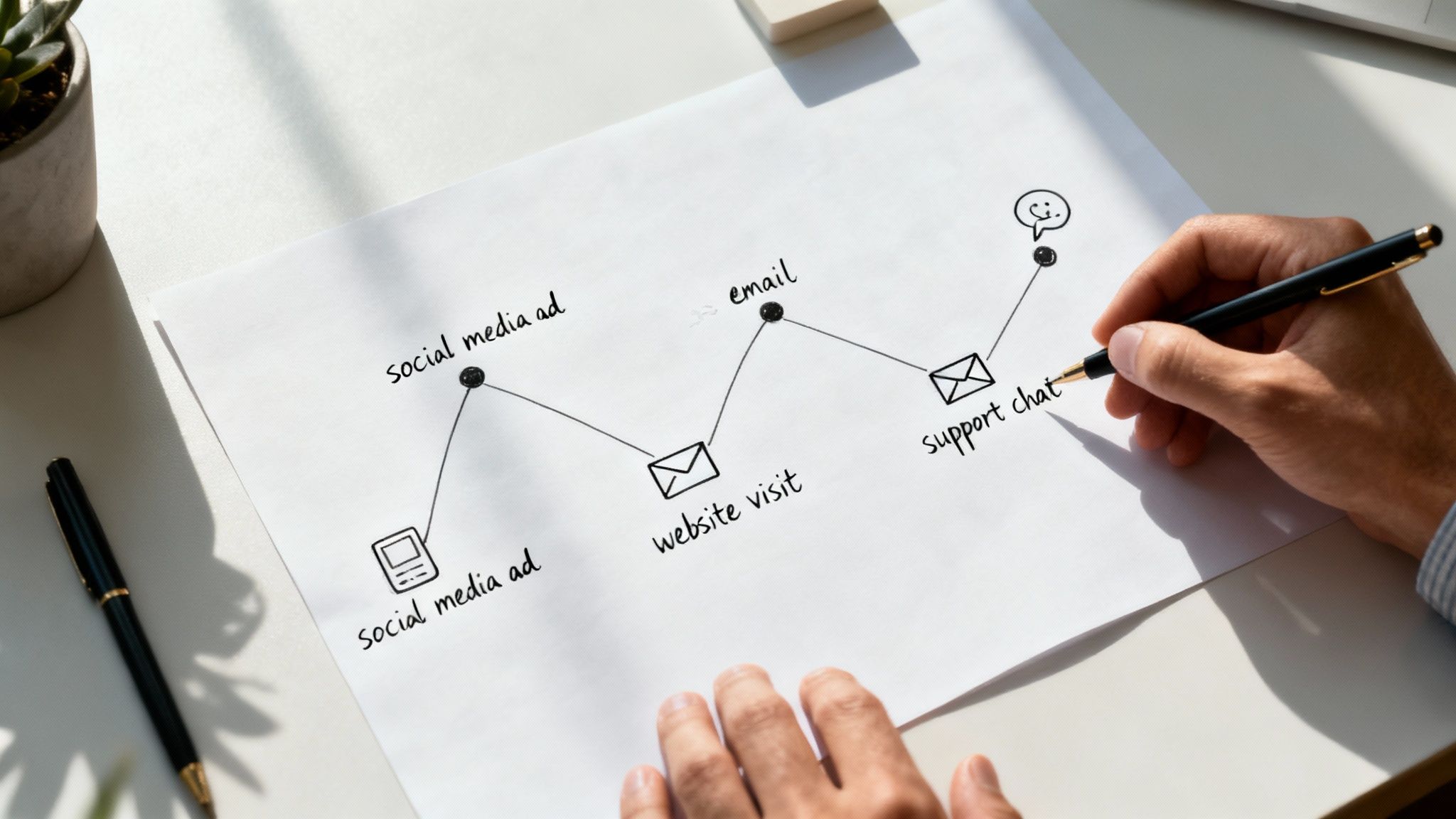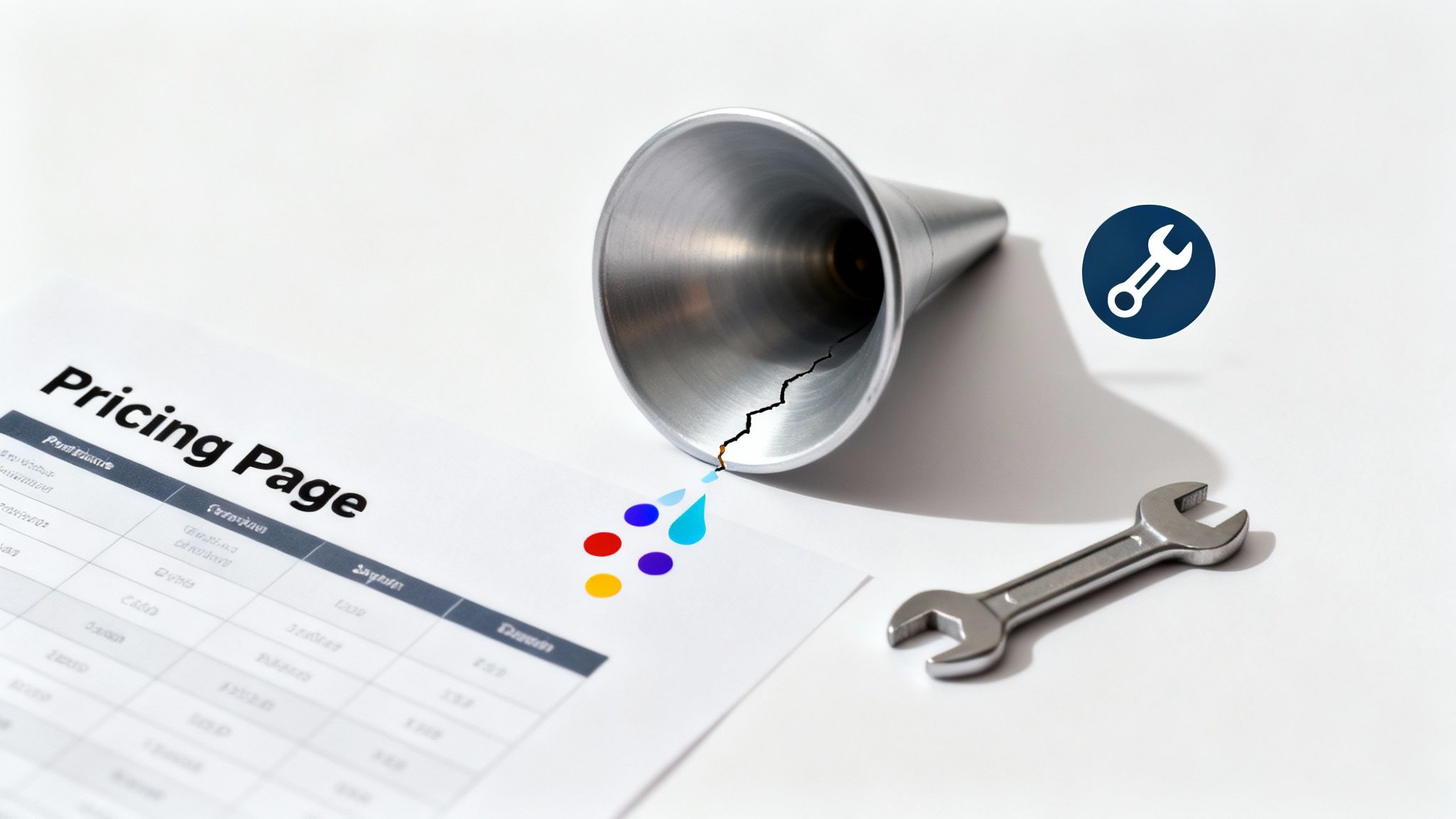How to Improve Forecast Accuracy: Stop Missing Your Targets
how to improve forecast accuracy with practical steps to reduce error and consistently hit targets.
Learn how to optimize your customer journey funnel with actionable strategies to boost conversions and drive growth. Discover the key steps today!
TL;DR: The customer journey funnel is your roadmap to turning strangers into loyal fans. Understanding its five stages—Awareness, Consideration, Conversion, Loyalty, and Advocacy—helps you pinpoint exactly what customers need at each step, fix leaks in your process, and build a predictable engine for growth.
Think of the customer journey funnel as a roadmap for your business. It’s the path you lay out to guide total strangers from their first "hello" all the way to becoming your biggest fans.
It’s not just a sales gimmick; it’s a visual map that tracks every step, from initial awareness to that all-important repeat purchase. When you truly understand this path, you can start to spot where people are dropping off, improve their experience, and build a much more predictable engine for growth.
A customer journey funnel is simply a model that visualizes the entire lifecycle a potential customer has with your brand. It kicks off the very first moment they hear about you and carries on long after they've bought something.
This isn’t just about tracking deals; it's a complete framework for understanding how your customers think and act at different moments in time.
By breaking this complex process down into clear, manageable stages, you can pinpoint exactly what your audience needs from you at each step. This is a much bigger picture than just looking at your sales pipeline stages, because it wraps in the entire customer experience, from marketing to sales to support.
Ultimately, the goals are pretty straightforward:
This simple infographic gives you a great visual of the basic flow.

As you can see, the funnel gets narrower as it goes down. That’s by design. You're systematically guiding a broad audience toward the final, focused goal of making a purchase.

The customer journey funnel isn't some rigid, one-size-fits-all model. It’s better to think of it as a flexible framework that maps out the predictable path your customers take. When you break this journey into five distinct stages, you can get inside your customer's head and deliver exactly what they need, right when they need it.
Let's walk through each stage and see how a potential customer goes from a curious stranger to a loyal brand champion.
This is the very top of the funnel. It's that "aha!" moment when a potential customer first realizes they have a problem or a need. They aren't looking for your product yet; they're just looking for answers.
Your main goal here is simple: get noticed by being genuinely helpful.
Imagine a sales manager realizing her team is burning way too much time on manual account research. She isn't searching for "Salesmotion." She's Googling things like "how to reduce sales research time" or "tools for automating account planning."
Your job is to meet her there with content that actually adds value. This could be:
The key is to educate, not sell. You're building trust by being the resource that helps them make sense of their challenge. For a deeper dive into finding these potential customers, check out our guide on effective B2B prospecting strategies.
Once a prospect understands their problem, they slide into the consideration stage. Now, they're actively digging in and comparing potential solutions. They know what they need, and they're trying to figure out who can deliver it best.
Our sales manager now knows that "account intelligence platforms" are a thing. She's comparing features, reading G2 reviews, and looking at case studies from different companies. This is where you have to prove why your solution is the clear winner.
Your goal in the consideration stage is to move from being an option to being the option. You do this by providing proof, building confidence, and clearly demonstrating your unique value.
At this phase, your content needs to be more persuasive and product-focused. Think about creating comparison guides, detailed case studies, free webinars, or product demo videos. Every piece of content should scream, "Why us?"
The conversion (or decision) stage is the moment of truth. The prospect has done their homework, the credit card is metaphorically in hand, and they're ready to make a move. Your job is to make this step as smooth and frictionless as humanly possible.
Any friction here—a clunky checkout process, confusing pricing, a slow-loading page—can kill the deal instantly. The average conversion rate across industries is just 2.35%, and landing pages that load in one second can convert 2.5 times better than those that take five. It's a game of inches.
To nail this stage, you need to focus on:
Here’s a truth many businesses forget: the journey doesn't end with a sale. The loyalty stage is where you turn a one-time buyer into a repeat customer who sticks around for the long haul. It's almost always cheaper to keep a customer than to find a new one.
This phase is all about delivering a stellar post-purchase experience. Great customer support, a thorough onboarding process, and proactive communication are non-negotiable. You want your customers to feel valued and, more importantly, successful with your product.
This is the final and most powerful stage of the journey. Advocacy is what happens when a happy customer becomes a true brand champion. They don't just use your product; they actively promote it to their network through word-of-mouth, online reviews, and social media shout-outs.
Advocates are your most valuable marketing asset, period. To create them, you can build referral programs, feature customer success stories, and foster a community where users can connect. When your customers start selling for you, you’ve truly mastered the customer journey.

Understanding the stages of a customer journey funnel is one thing, but applying that knowledge to your own business is where the real magic happens. Building a customer journey map is how you turn abstract concepts into a practical, visual tool your whole team can actually use. Think of it as your blueprint for a better customer experience.
So, let's get from theory to action. This isn't about creating a perfect document on your first try. It's about starting a process of discovery that shows you exactly where your customer experience shines and—more importantly—where it’s falling flat.
Before you can map a journey, you have to know who is taking it. The single most important first step is to nail down your customer personas. A persona isn't just a fluffy marketing exercise; it's a semi-fictional, data-backed picture of your ideal customer.
Trying to map the journey for "everyone" will leave you with a generic map that helps no one. Focus on your most common customer type first. A B2B sales leader, for example, is on a completely different path than a small business owner—they have different goals, pain points, and motivations.
You're trying to answer questions like:
Gathering this info means digging into both quantitative data (from your CRM and analytics) and real, qualitative insights. A Salesforce report found that 80% of customers now say the experience a company provides is just as important as its products. Understanding their perspective isn't optional.
A touchpoint is any moment a customer or prospect interacts with your brand. These are the building blocks of your map. It’s easy to focus on the obvious ones, like your website or a sales call, but the real journey is always more tangled and complex.
Your job is to brainstorm every possible interaction, no matter how small it seems. Think across the entire lifecycle, from the moment before they even know you exist to long after they’ve become a loyal advocate.
A customer journey map is more than a diagnostic for the customer experience. It’s also a diagnostic for your internal teams. It shines a light on where your people, tools, and processes are either helping or hurting the customer’s journey.
Your list of touchpoints might include things like:
Just getting this list down on paper helps you see the journey from their side of the screen, and it almost always reveals awkward gaps or jarring inconsistencies you never knew were there.
Okay, you have your persona and a long list of touchpoints. Now it's time to connect the dots and map them to the stages of your customer journey funnel. This is where your map starts to really take shape.
Create a simple grid or timeline. The horizontal axis represents the funnel stages (Awareness, Consideration, Conversion, etc.), while the vertical axis can list the customer's actions, thoughts, and feelings at each step.
For each stage, plot the relevant touchpoints. For example, under "Awareness," you might list "Sees LinkedIn Ad." Then, you'd document the persona’s likely action ("Clicks the ad"), their thought process ("Hmm, this might actually solve my team's research problem"), and their emotion (Curious, hopeful).
This part of the process forces you to build genuine empathy. It shifts your entire focus away from your company's internal process and onto the customer's real-world experience, highlighting those make-or-break moments of frustration or delight.
Finally, a good journey map is a measurable one. To make your map truly actionable, assign key performance indicators (KPIs) to each stage. This transforms it from a static document into a living tool you can use to track performance and spot leaks in your customer journey funnel.
When you tie data to each stage, your map becomes a powerful diagnostic tool. A sudden drop in demo requests, for instance, immediately points to a fire you need to put out in the Consideration stage.

A customer journey map is way more than just a pretty diagram to stick in a slide deck. Its real power comes from using it as a diagnostic tool—a way to find and plug the leaks where potential customers bail on their journey. This is where you stop guessing and start using data to drive real growth.
Think of your funnel like a series of pipes. If the water pressure drops, you don't just start randomly patching sections. You inspect every connection to find the exact source of the leak. It’s the same with your funnel. A huge drop-off between your pricing page and checkout isn't a mystery; it’s a flashing red light telling you exactly where to focus.
When you start approaching it this way, your customer journey funnel shifts from a static document to a living, breathing tool for constant improvement. You find the weak spots, test solutions, and make a measurable impact on your bottom line.
The first step to fixing a leaky funnel is to figure out where the water is actually escaping. This means diving into your analytics and looking at the customer journey through a quantitative lens. Funnel analysis is a perfect technique for this, as it visually shows how people move through a series of steps, making it painfully obvious where they disappear.
You might see a nice, steady flow of users through your blog and product pages, only to find a massive cliff-dive when they hit the sign-up form. That’s your leak.
To get started, zero in on a few key areas:
Once you've found a leak, it's time to test some patches. This is where a methodical approach like A/B testing is absolutely essential. Instead of making changes based on a hunch, you test one version against another to see what actually moves the needle.
Optimization isn’t a one-and-done magic trick. It's a continuous cycle of spotting problems, forming a hypothesis, testing solutions, and making small improvements that add up to big wins over time.
To give you some ideas, we’ve put together a quick table outlining common optimization tactics for each funnel stage.
| Funnel Stage | Key Metric to Improve | Optimization Tactic Example |
|---|---|---|
| Awareness | Click-Through Rate | A/B test different ad headlines or blog post titles. |
| Consideration | Sign-up Rate | Simplify the demo request form from five fields down to two. |
| Conversion | Cart Abandonment Rate | Add trust signals like security badges and customer reviews. |
| Loyalty/Retention | Churn Rate | Test personalized onboarding emails versus a generic welcome series. |
The tactics you use will depend entirely on where your specific leaks are, but these examples should get the wheels turning. Here are a few more common optimization strategies to consider:
By applying these data-driven strategies, you can systematically patch the leaks in your customer journey funnel. You’ll ensure more prospects make it all the way from curious stranger to happy customer. For a deeper dive, check out these expert conversion rate optimization tips.
Let's be honest, the classic customer journey funnel is a great starting point, but it paints a picture of a clean, straight line that almost never happens in the real world. Today’s customer journey is messy. It’s a web of interactions stretching across a dozen channels, often happening completely out of order.
To win today, you have to move beyond a one-size-fits-all model and get a lot more sophisticated. A Fortune 500 executive kicking the tires on your enterprise plan has a totally different set of needs than a small business owner eyeing your basic package. Treating them the same is a surefire way to lose them both.
The first step toward a smarter funnel is segmentation. This is simply the practice of breaking your audience into smaller, more focused groups based on shared traits and then building a unique journey for each. Instead of one giant, leaky funnel, you end up with several smaller, highly effective ones.
You can slice your audience in all sorts of ways:
By tailoring the journey, you can deliver messaging that truly connects. For example, a visitor who clicked an ad targeting the healthcare industry should land on a page packed with hospital case studies, not testimonials from tech startups. It just makes sense.
While segmentation looks at who your customers are, cohort analysis looks at when they started their journey and what they do over time. A cohort is just a group of users who share a common starting point, usually the date they signed up.
Think of it like tracking different graduating classes. You can compare the “Class of January” to the “Class of February” to see how their behavior changes. Did a product update in February lead to better long-term retention? Did that new onboarding flow you launched in March actually reduce churn for that month's new users?
Cohort analysis shifts your focus from a single conversion event to long-term customer value. It helps you understand not just if customers convert, but if they stick around and stay engaged.
This is a powerful way to spot trends and measure the true impact of the changes you're making to your product and marketing.
One of the biggest flaws in old-school funnel analysis is giving 100% of the credit for a sale to the very last thing a customer did—that final click before pulling out their credit card. Multi-touch attribution fixes this by spreading the credit across all the interactions a customer had along the way.
Did a customer first find you through a blog post, see a LinkedIn ad a week later, and finally click a link in your newsletter to buy? Each of those touchpoints played a role. A "last-click" model completely ignores the blog and the ad, which might lead you to slash your content budget, thinking it's not working. Modern customer journey optimization relies on integrating these diverse data sources to visualize complete journeys and uncover valuable insights.
By adopting these advanced techniques, you move from a rigid, linear view to a flexible, data-driven understanding of how customers truly behave. For anyone serious about continuously improving their funnel, exploring sophisticated approaches like growth hacking strategies can unlock massive results. This smarter approach is how you build a customer journey that's not just effective, but resilient.
Trying to manage a modern customer journey with spreadsheets and sticky notes is like trying to navigate a new city with a map you drew from memory. You might get a few blocks, but you’re going to get lost, miss crucial turns, and ultimately fall way behind.
To build a high-performing, data-driven funnel, you need a smart tech stack where every tool works together. Your toolkit doesn't need to be massive, but each piece has to serve a crystal-clear purpose at a specific stage. The goal is a seamless system that attracts, nurtures, and converts—all while giving you the insights to get better at every step.
Up at the top of the funnel, it's all about getting noticed. This means creating content people actually want and making dead sure the right audience finds it.
Once you've grabbed someone's attention, the next set of tools takes over. Their job is to guide people through the consideration and decision stages, and this is where personalization and relationship-building become everything.
The right technology transforms your funnel from a simple flowchart into a dynamic, responsive system. It allows you to automate personalized engagement based on a user's behavior, ensuring every interaction feels relevant and timely.
A Customer Relationship Management (CRM) platform like HubSpot is the central nervous system for your entire funnel. It tracks every single interaction a lead has with your brand—from email opens to page views—giving your sales and marketing teams the context they need to have meaningful conversations.
Here's an idea of how a modern platform can pull all that crucial account data into one place for your teams.
This kind of dashboard shows how today's tools consolidate key signals, giving everyone a unified view of what’s happening and where to focus.
On top of that, a web analytics platform like Google Analytics is your detective for finding leaks in the funnel. It gives you the hard data on user behavior, showing you which pages are killing it and where people are dropping off. That insight is gold for optimizing the path to purchase.
For B2B companies, a modern sales intelligence platform adds another, deeper layer of insight. It helps you understand account-level buying signals so you can perfect your timing and messaging.
When you integrate these tools, you're not just buying software; you're building a powerful, interconnected system. Your SEO tool brings in traffic, your CMS gives it a place to land, your analytics platform tracks what happens next, and your CRM manages the entire relationship. That’s how a basic funnel becomes a predictable engine for growth.
Think of the customer journey funnel as the entire map, while a sales funnel is just one specific route on that map. The customer journey covers everything from initial awareness to long-term advocacy, whereas the sales funnel focuses narrowly on the steps a lead takes to become a paying customer.
You should review your customer journey map at least quarterly to ensure it reflects your customers' current behavior and your business goals. However, the key metrics for each stage should be monitored much more frequently—weekly, or even daily—to catch any issues early.
Yes, absolutely. Most businesses benefit from creating multiple funnels tailored to different customer segments, products, or marketing channels. An enterprise client will have a very different journey than a small business owner, and your funnels should reflect that to be truly effective.
Ready to stop guessing what your B2B customers are thinking? Salesmotion uses AI to monitor real-time signals from your target accounts, delivering the exact insights you need to personalize your outreach and accelerate your pipeline. See how it works at https://salesmotion.io.
how to improve forecast accuracy with practical steps to reduce error and consistently hit targets.
A practical guide to the B2B sales funnel. Learn to build, measure, and optimize your funnel with proven strategies for converting leads into...
Unlock predictable revenue by mastering pipeline velocity. Learn the formula, key levers, and proven strategies to accelerate your sales cycle and...